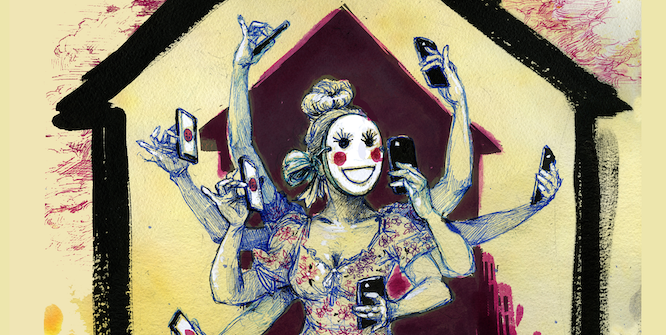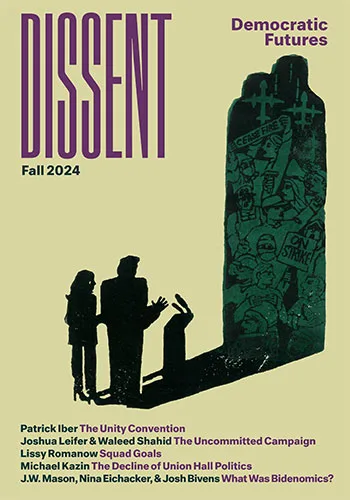The Agoraphobic Fantasy of Tradlife
The Agoraphobic Fantasy of Tradlife
In an increasingly expensive and antisocial world, tradwives forsake life with others for the lonely, constrictive spaces of bourgeois ownership.

Love is the ultimate value, and love is under threat. That is the rumor we good, secular citizens are hearing, at a time when capitalism’s fatal drag on human affections has become harder than ever to ignore. Love is being lost to modern promiscuity, to social alienation, to the degraded hours of work and separation that spread, like static, between the members of your average American family. If only there was a way to save love—and them! Well, respond the reactionaries: the way to rediscover true feeling and value lies in tradition—in, more specifically, tradlife.
“Tradlife” is the handy neologism for a recent set of attitudes and lifestyles devoted to glorifying the nuclear family and its jolly scenery; it is often promulgated by the new right, though followers retain a confusing span of affiliations. Even as tradlife looks backward, its pursuit and its rites are communicated mostly over social media in role-playing and image-making, the principal languages of such platforms. Followers post photos and videos of their ostensibly traditional families, wreathing their content with artful connotations of romance, safety, and leisure. Wives narrate to cameras the good fortune they’ve found in being kept women and living alongside stoic breadwinners; they publish pictures of their houses and vacations, which are visibly expensive.
The twist that makes tradlife a phenomenon of our times is that it also includes earnest criticisms of life under capitalism. Many tradlifers are young women who hate work and celebrate arrangements where men rescue their wives from the professional realm: “When my friend’s mom first started dating her husband,” one viral tweet reads, “he said ‘Stay with me, marry me, and you’ll never have to work again.’” Only tradition can salvage love from modern indignities and the early-morning commute. Like a trapdoor, the idea swings open to reveal a baby-pink fantasy too fragile and nostalgic to be taken in the open air. Regular people preoccupied with bills, healthcare premiums, and rising rents will find much of the tradlife lifestyle to be out of reach. That paradox is what makes it such potent social media fare: tradlife is, at bottom, perpetuated by “influencers” who know how to make others feel desirous and frustrated in equal measure. It is a menacing advertisement jingle, for a product people may not want or be certain exists.
By describing the misery of work, tradlife ennobles itself. But as an ethos it also maintains a willful stupidity about modern capitalism’s historic dependence on the family, a constitutive structure of capitalism, through which property, debt, and economic interest are all consolidated (it was Milton Friedman, after all, who wrote that “the ultimate operative unit in our society is the family”). As a concept, “the family” has worked even harder than “the individual” to overshadow our ethical obligations to other people. But few have use for notions of society anymore, defined as it is by unpredictability and fear of rising crime. We want only securitized intimacy—the happy assurance of a shared mortgage.
Like all lore, tradlife has a central hero: the tradwife is a woman who abandons the workforce and retreats indoors to care for her husband. Unlike the suburban ideal of the 1950s, with its white broods of children, the women in these videos are only sometimes mothers. This is perhaps because babies can place strain on the tradwife’s reigning aesthetic: a gauzy brand of femininity where everything, but especially marriage, is meant to be easy. Roles are spontaneously desired because housewifery is now, unlike last time, a choice to be plucked out and guarded jealously from alternatives. In their videos, tradwives drift slowly through minimalist rooms and narrate their days (morning supplements, laundry) in sedate tones: “I fill up Luke and I’s [sic] water bottles to make sure we’re hydrated.” Perhaps it’s the nature of the genre—“daily routine” videos are popular online—but the tradwife’s schedule always seems viciously regimented. Unpredictability and genuine surprise are rare, as are appearances by other people. At its extreme, the lifestyle is agoraphobic.
Despite the monotony, iterations of the tradwife proliferate. There are the authentic doctrinaires: real corn-fed Mormons who forswear premarital sex, who indeed want and have children, and who must be distinguished from the Catholic converts; the latter more often self-style as coquettish girlfriends rather than wives. Then there are the army wives and the wives of power-line technicians, called “line wives” (there is more class than racial diversity in tradwifery, though the content is not as white as one might assume). Next is the back-to-nature wife, well-plaited and a capable manager of her farmstead. The conservative wife, meanwhile, is more shock jock than influencer; she will proselytize right-wing virtues directly to the camera, describing them as locked in a life-or-death battle with a degenerate and impossibly influential leftism. There are also women living in big cities with advanced degrees, leftists themselves, who traffic in half-ironies and conscious displays of heterosexual longing.
Each wife has her own content stream and audience. Some wives primarily address other women, marketing themselves as either role models or scolds. Others post for the benefit of men, having discovered male attention to be a lucrative feedback loop: the more one professes to love it, the more one receives. Rules of taxonomy are difficult to divine, but I would hazard that often it is the upper-class wives who craft their image for men, which is not to say that the thing is more genuine when it’s acted out before women. In either case, tradwifery is an online performance, which explains the vast spread of genres, vocabularies, and poses it renders available.
What unites tradwives is their rejection of both capitalism and feminism, which are conflated in the gloomy figure of the working woman. Through a sleight of hand, the cloth is whipped away and feminism revealed as a defunct and joyless system of hatred. Tradwomen have no use for it; they rebel against rebellion, and are content with—even romantic about—their roles of dependence and servitude. They profess to love men and masculinity, to hate the notion of gender fluidity or egalitarian partnership. And yet, after watching enough tradlife content, one starts to wonder if, in addition to love, there also exists among tradwives a real fear of men. After all, the homebound tradwife has managed her life such that she rarely interacts with men as a group. She has no male coworkers; if she sees men socially, they are either the harmless husbands of women she knows, or her family members. To be alone with an unfamiliar man would be a singular taboo. In all, the tradwife deals with one male figure, her spouse, and only then during the short hours before and after he goes to work (if she is an army wife, the absence can lengthen to months). It is an ironic development: in this way, the tradwife has proven herself not too different from the lesbian separatists of the second wave who she claims to detest. In disavowing feminism she actualizes one of its most infantile desires—reducing to a blessed minimum contact with men and the sexual threat (or promise) they pose.
Though commentators often describe tradlife as a response to capitalism’s failures, it thus seems likely that tradlife’s purchase was also strengthened by #MeToo and the pandemic, two phenomena that encouraged women to see life beyond the home as dangerous, an unmanaged territory where other people, especially men, lurk maliciously. That is not to belittle the real destruction that misogynistic sexual assault and COVID-19 have wrought; both are ongoing tragedies that reveal the deterioration of civic and economic protections for marginalized people within the public sphere. The danger of tradlife, however, is that it permits women to acquiesce to the state’s neglect of this sphere. In an increasingly expensive and antisocial world, tradwives forsake life with others for the lonely, constrictive spaces of bourgeois ownership.
#MeToo in particular exposes a problem for gender relations and women’s stance toward society: its deluge of revelations was shocking not because of the details of each act or assault, but because the resonance and iterability of those details seemed endless. Overnight, every man became suspect. The rot was structural. Any mass psychological effect of this outpouring has yet to be addressed, and even now that men and women still, despite everything, fall in love, they do not necessarily trust each other. Today, many women—not just angry feminists—feel resentful and unsure of the men in their lives. In an era of what scholar Asa Seresin calls heteropessimism, they frequently feel that to either compete with men professionally or date them casually is an ill-fated venture, affording few opportunities for progress or respect. Why not stay home?
On a macro and micro level, then, tradlife proffers a purportedly risk-averse solution to the political challenges that patriarchy and sexism present. It guards women from most men and from public life. Meanwhile, the ideology itself shies away from present-day discontent, further withdrawing from the world it purports to wish to change. The family has long been an exclusive realm, where people hoard both interpersonal and economic resources. Yet tradlife overlooks this contradiction of its own supposed anti-capitalism, supplanting it with the sharp and flawless grid of a pixelated image. Regardless of its nostalgic Americana, tradlife’s vision owes less to Norman Rockwell than Thomas Kinkade: the glitter is cold, and the insistence on perfection almost hysterical. Rockwell, even at his most idealized, still populated his work with people and their hijinks; he was interested in the capacity of individuals to surprise each other. Meanwhile, in its videos and photos of well-lit, private spaces, tradlife makes property rather than humans its central object. As in Kinkade’s paintings, the house appears as a refuge from others.
Perhaps all contemporary relationships are attended by hierarchy, and tradlife is just more honest about the power differentials of intimacy. But feminism, at its best, has always pointed to the possibility that love could one day be different. It has maintained that we do not currently know the full range of its possibilities, because love between men and women has so far only happened within a narrow patch of unjust conditions. Tradlife seeks the certainty of formulaic relationships, but it hides from its purveyors the prospect that a different kind of society may have better, different formulas, or no formulas at all. What might marriage look like without the imperative of property? How might love be lived without the dramas of jealousy, pain, and insecurity that crowd a world in which public space and dignity are never fully shared?
James Baldwin once wrote that real political change “implies the breakup of the world as one has always known it”; in short, it means “the end of safety.” Tradlife and its proponents struggle against this loss by choosing to look backward, but feminism, by identifying power’s tread across both personal and structural levels, must show that they do so futilely. As Baldwin said: “It is only when man is able, without bitterness or self-pity, to surrender a dream he has long cherished or a privilege he has long possessed that he is set free—he has set himself free—for higher dreams, for higher privileges.” This is another way of saying that there are two doors before us. Behind the first is what we know and have long understood to be irrevocably impoverished. Behind the second is something we cannot yet see or understand: the total overhaul of our social relations, and how that might be felt and experienced.
The second door belongs to feminism, which can countenance what is anathema to most political philosophies—humility regarding change’s slow shaping, and an understanding that the future cannot be clairvoyantly programmed. Love is universal, maybe, but it is not immutable. We cannot know what its higher privileges will be—we can only gradually improvise them, while knowing that the highest privileges will shed the very meaning of the word, when they are finally shared by all.
Zoe Hu is a writer and PhD student at the CUNY Graduate Center.




